Jacob & Co.
The Story of Jacob Arabo
James Truslow Adams, The Epic of America, 1931
I’ve seen a lot of watches in my life. So, it’s rare for me to have a genuine moment of revelation. The whole “Archimedes in the bathtub, witnessing the water level rise and suddenly comprehending volumetric displacement, Eureka” thing. But the first time I actually held a Jacob & Co. Astronomia in my hands, I had to admit I was blown away. Sure, I had seen watches that placed the oscillator — the beating heart of the watch — on the dial, often in tourbillion format, and made it rotate around the perimeter. This was the idea behind Ulysse Nardin’s Freak created by Ludwig Oechslin and also Piaget’s Tourbillon Relatif designed by the brilliant Carole Forestier. (To be fair, the first concept of the Freak also came from Forestier.) But the Astronomia took the dial side animation initiated by these two watches and smashed it through the stratosphere to achieve an altogether different level of visual pyrotechnics and horological badassery.
Here now was a mini-amphitheater contained within one of the most technically innovative and theatrically dazzling displays of time transformed into celestial poetry I had ever witnessed. It featured a four-arm carriage driven by a single almighty massive mainspring at the base of the watch. As the carriage turns, it compels — count ’em — a triple-axis gravitational tourbillion; a floating differential driven hour and minute dial with the miraculous capacity to always stay oriented upright; a 288-facet diamond and a miniature magnesium globe rendered in exquisite detail to represent the earth that both rotate once every 60 seconds, to all come to life. This carriage completes a full clockwise revolution every 20 minutes.
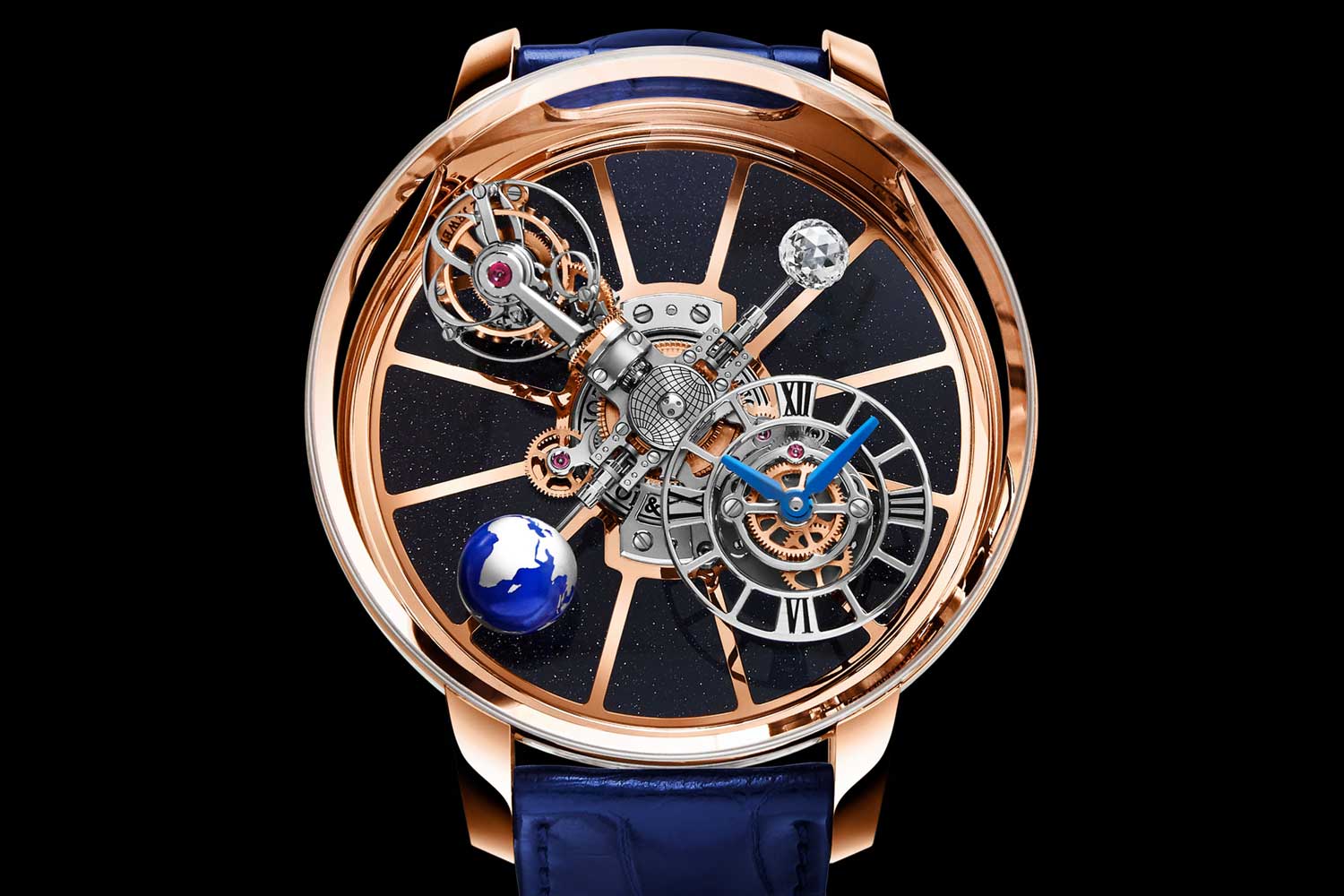
The awe-inspiring Astronomia with its distinctive four-arm carriage that completes a full clockwise revolution every 20 minutes
I wanted to understand why he was so focused on creating the most ambitious acts of technical innovation coupled with visual pyrotechnics. Moreover, I wanted to know what his watches look, feel and sound like in the metal. Finally, I had the opportunity to broach the subject with him at the fantastic Dubai Watch Week organized by the Seddiqi family. When I raised the topic about visiting him to learn more about his unique vision for watchmaking, Jacob said, “When do you want to leave? I have a jet.” This typically generous offer, I would learn, is simply part of who Jacob is. He is fast, decisive, direct and instinctive in everything he does. In the end, our schedules didn’t permit me to take him up on his incredibly kind offer. But several weeks later, I found myself at the front door of Jacob’s stunning townhouse on 57th between Park and Madison in New York to meet him and his son Benjamin Arabov, who has taken over as CEO of Jacob & Co. since 2021.

Jacob Arabo

CEO of Jacob & Co. Benjamin Arabov
“It was simple,” says Jacob, “We always made them feel welcome. We always make everyone feel as if they are home here.” And so, the first surprise about the Jacob experience is that, despite the fact that the average watch on display likely has a price tag in excess of a quarter million dollars, you are instantly made to feel at home. Clearly, this comes from Jacob himself. He explains, “I love the American Dream where anyone can rise up and become successful. They can, based on the strength of their own character, their determination and their hard work, create limitless success for themselves. When we had hip-hop guys or musicians or actors come to us, I loved this because I understood the success they were experiencing. I wanted anyone who wanted to celebrate success to be able to come to us.”
Of course, Jacob understood the American Dream better than anyone — because he was the perfect representation of it himself.
The American Dreamer
The story of Jacob Arabo is singular. It is a story of extraordinary entrepreneurialism and vast resilience. It is the story of boundless imagination. Above all, it is the story of a man who loves his family. It is so intrinsically linked with the very fabric of the American Dream that if Jacob didn’t exist, America would have had to invent him, replete with a Neil Diamond soundtrack. Over dinner at Casa Cipriani, the members-only spot for New York’s glitterati situated at New York’s southernmost point and fittingly overlooking the Statue of Liberty, he says, “My father was an educated man. Before we came to the United States, he would manufacture and distribute a wide array of different liquors. But at the time under the Soviet regime, there weren’t many opportunities to have a better life. So, in 1979, he decided to bring our family (from Tashkent, Uzbekistan) to America. He found that his prospects were a lot more limited. He tried really hard to find work. But he really had trouble making ends meet, and so, at 17, I dropped out of high school to help support my family.” Jacob and his family eventually settled in Queens. Despite his whirlwind pace, transglobal life, Jacob and his son Benjamin have never lost sight of their roots. Benjamin says, “We all live in the city during the week, and we all live our separate lives. But on the weekend, the family all goes back to our house in Queens to spend our time together.”

Jacob as a teenager
It was his love for his family that compelled Jacob to become a jeweler. After dropping out of high school at 17, he enrolled in a jewelry making course. He finished the six-month course in just four months and soon got a job in a local jewelry factory. He recalls, “It was really like ‘here’s a hundred gold bracelets, weld them together.’” It was around this time that Jacob realized he had an eye for design. He says, “I was always curious about design. Why one object using the same materials could be so much more beautiful than another one using exactly the same materials. Why some designs spoke to me while others didn’t. Around the same time, I started to become interested in photography, and I learned about perspective, detail, lighting and all the things that made something beautiful. More importantly, I realized I knew what other people would think was beautiful.” This self-awareness compelled Jacob to quickly move from working as a craftsman in a jewelry factory to designing pieces of his own.

A snaphot from the archives, circa 1980s
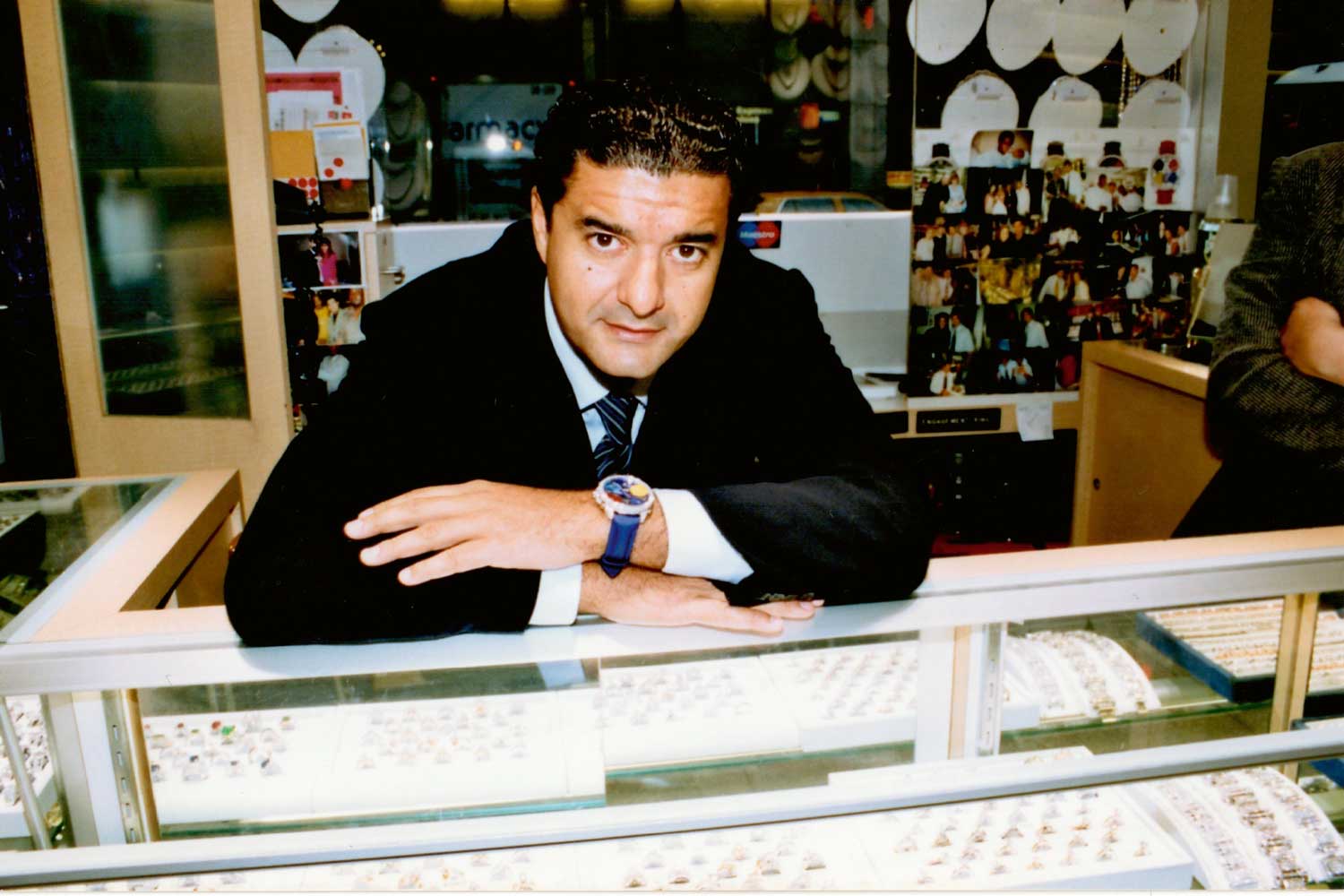
Jacob Arabo at his Sixth Avenue jewelry boutique in 2000
King of Bling
Says Jacob, “The reason I think they all came to me was, firstly, I always treated them with respect. As a young person, I genuinely admired what they did. I admired their success. Secondly, I wanted to create the styles of jewelry they wanted, but executed at the highest level with the type of craftsmanship and stones that were the very best.” In a few short years, Jacob would find himself commemorated in the lyrics of contemporary music’s most famous luminaries, including Jay-Z in “Girl’s Best Friend,” 50 Cent in “Get in My Car,” Beyoncé in “Upgrade U,” Big Sean in “First Chain,” Rick Ross in “Live Fast, Die Young,” A$AP Ferg in “Mazel Tov” and, most famously, Kanye in “Touch the Sky” with the immortal lyrics: “I went to Jacob an hour / After I got my advance, I just wanted to shine.”
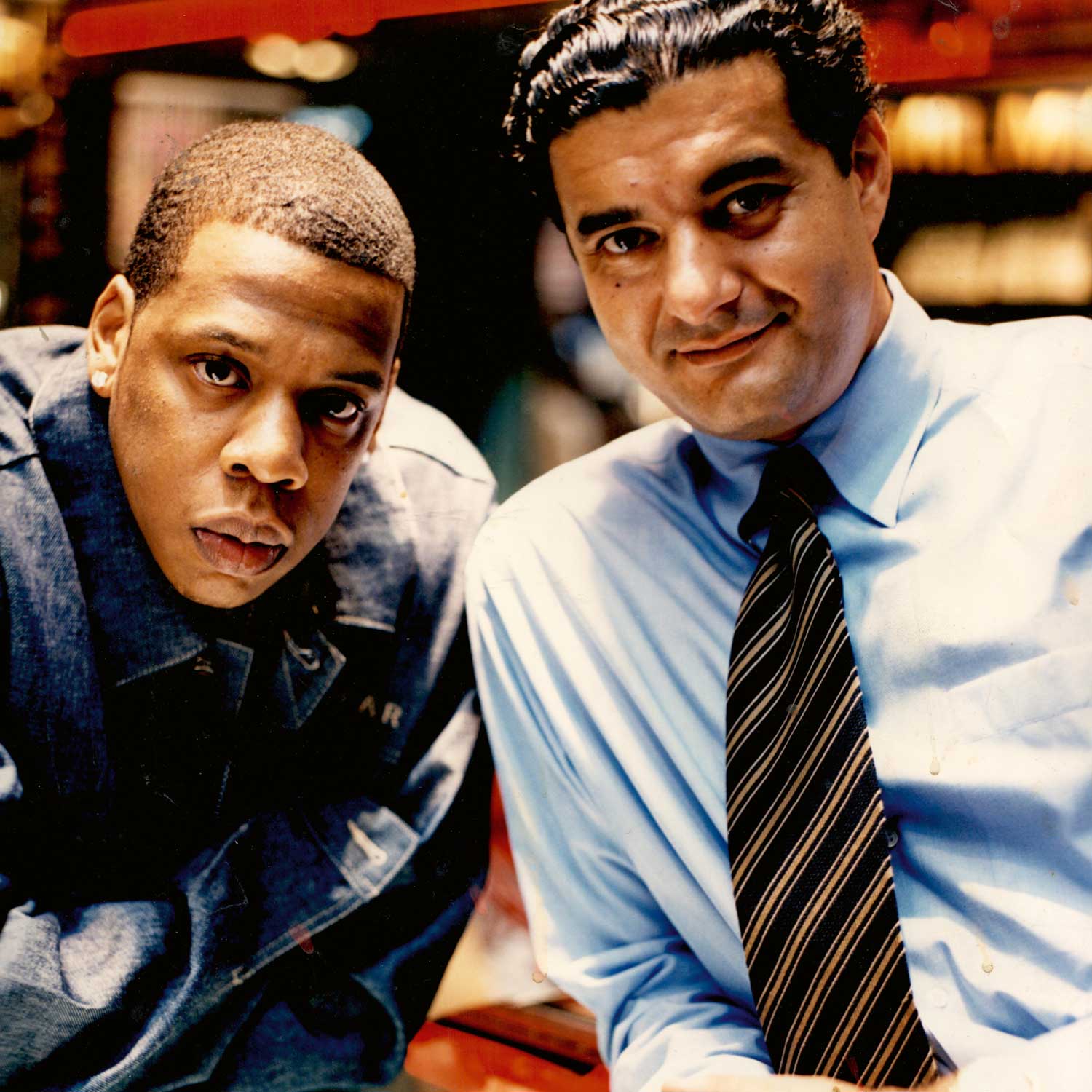
Jacob Arabo's influence on hip-hop style and popular culture is massive. Pictured here with Jay-Z
Jacob’s influence on hip-hop style and culture is massive. Hip-hop style has now been channeled to become “streetwear,” the single most financially significant fashion genre. This was clearly and irrefutably announced to the world when Louis Vuitton appointed Jacob’s friend, the late Virgil Abloh, as its creative director. But it must be said that Jacob has had a significant hand in shaping contemporary culture as we know it today. The very concept of “bling,” the addition of gemstones to men’s watches, has become so prevalent today that without Jacob, Rolex’s Rainbow Daytona, Patek’s 5711 with baguette diamond bezel and a wide range of Audemars Piguets such as the 41mm tourbillon with emerald bezel, would probably not exist today. Says Grand Prix d’Horlogerie de Genève jury member Austen Chu, “Go anywhere from Ibiza to Mykonos this summer, and you’ll see men wearing full-gem-set watches on their wrist and diamond pendants around their necks.” Swag, drip, bling, whatever you want to call it, Jacob has, through his influence on hip-hop culture, created this.
Hottest Watch on the Block: Jacob’s Five Time Zone
In 2002, fueled by his stratospheric rise to become the most famous living jeweler in the world, Jacob launched his first watch, one that would become the single most iconic timepiece in hip-hop and street culture. This was his Five Time Zone watch — a round watch with central hands and, in each corner of the dial, an additional set of hands. The dial and the removable bezel were invariably gem-set and “blinged” to the max. It is impossible to overstate how popular this watch was. The titans of hip- hop including Jay-Z, Kanye and Busta Rhymes, Nigo of Bathing Ape, Pharrell Williams, Bono, David Beckham and even Leonardo DiCaprio were clocked wearing a Jacob Five Time Zone back in the day.
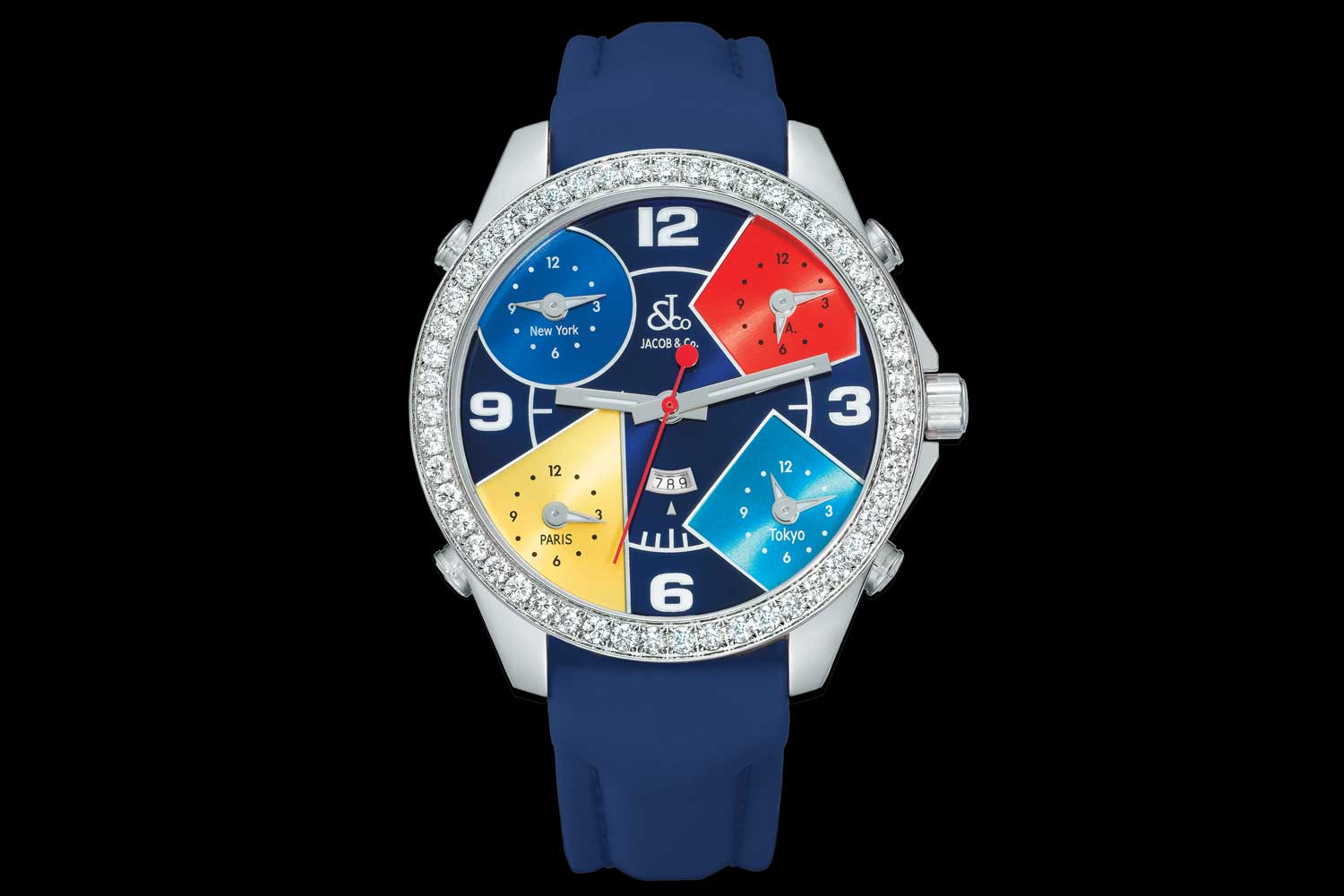
The coveted Five Time Zone
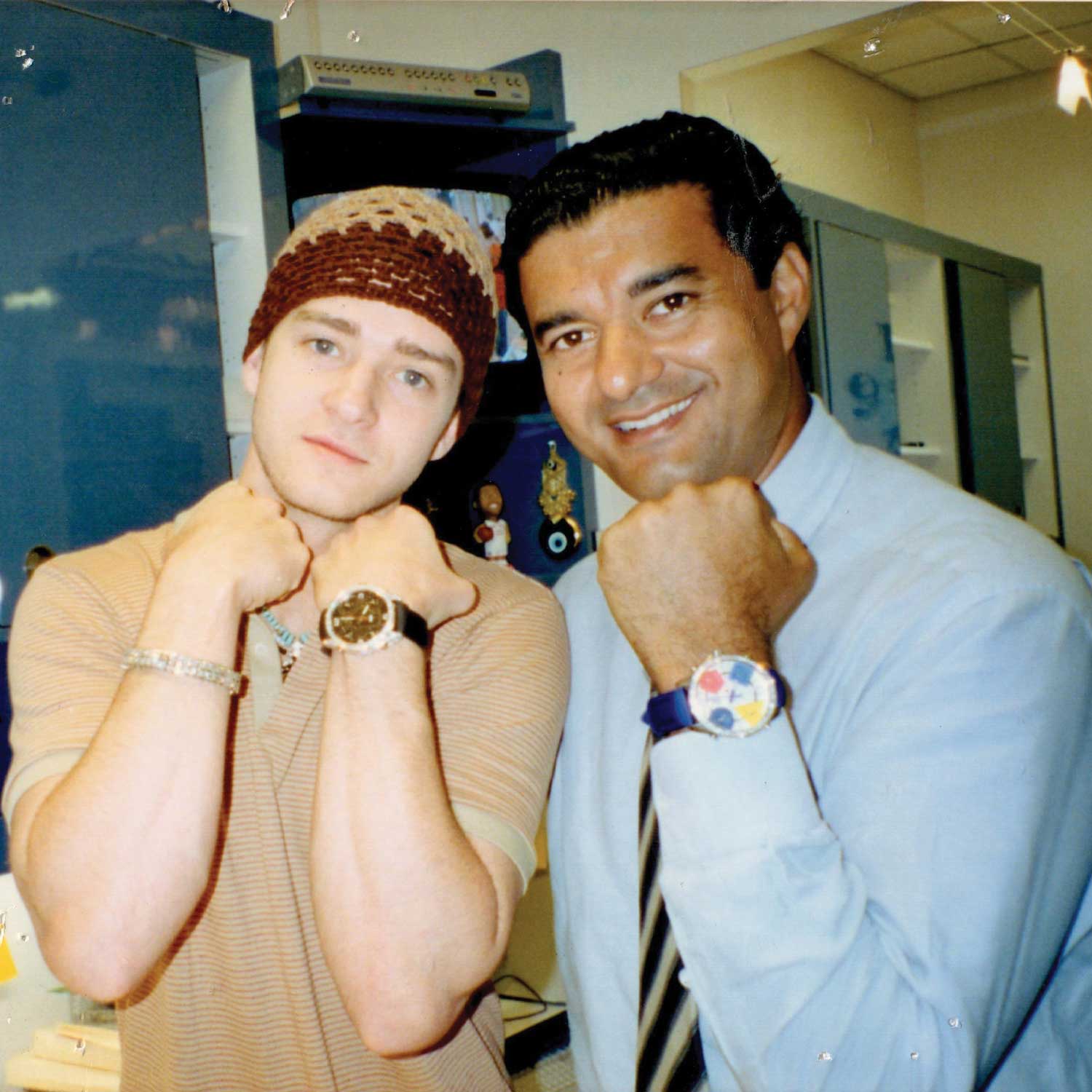
Jacob with Justin Timberlake
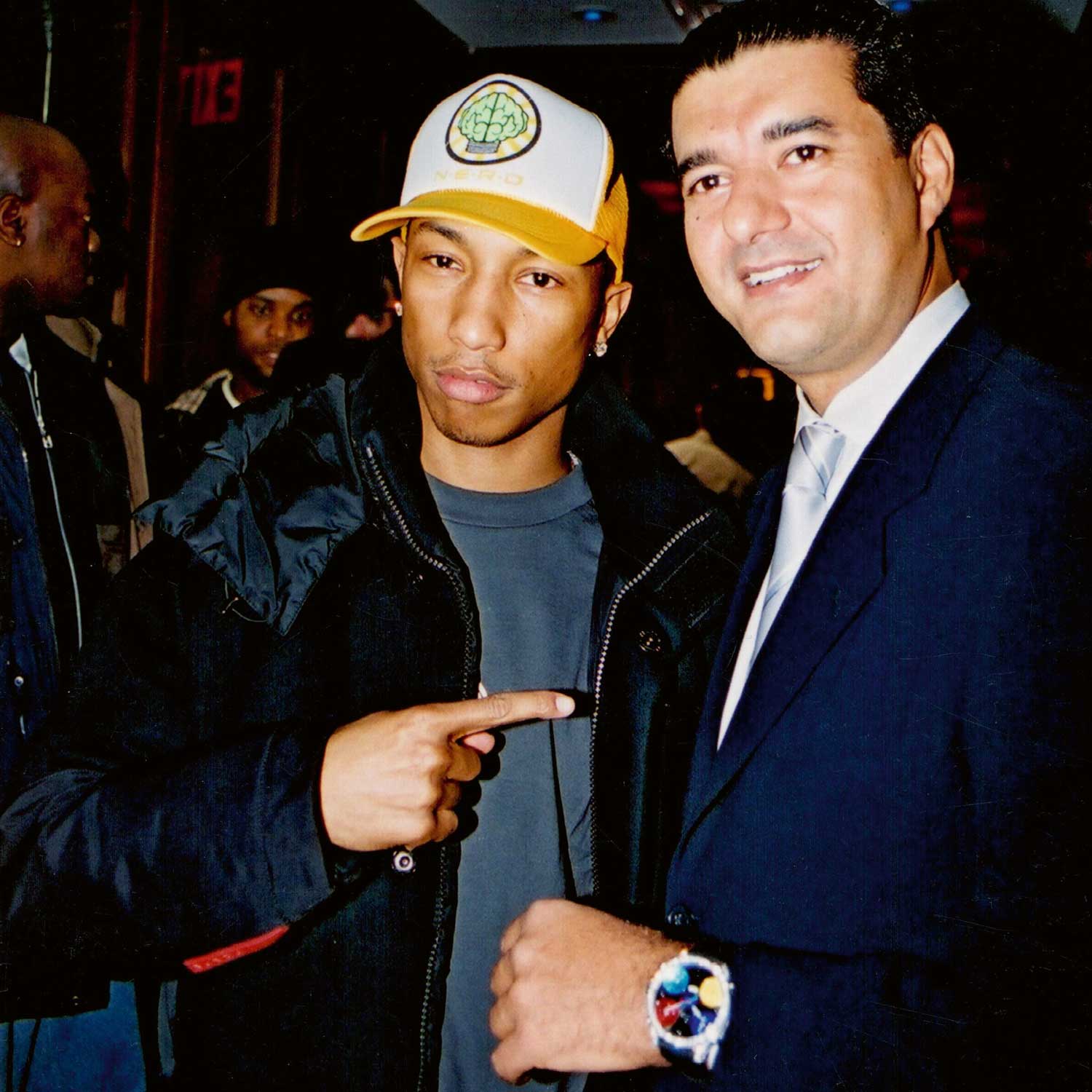
Jacob and Pharell
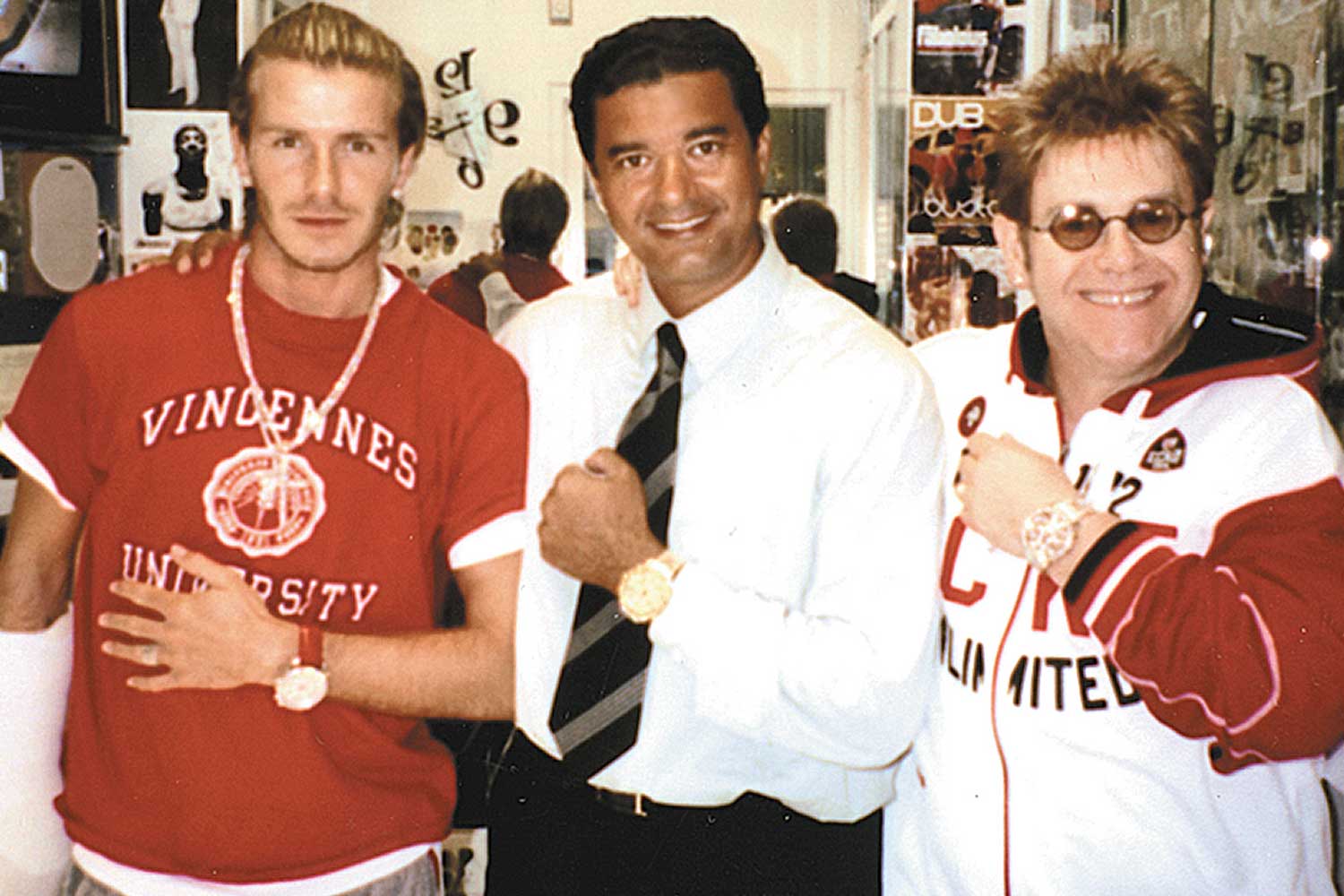
David Beckham and Elton John wear Jacob and Co.
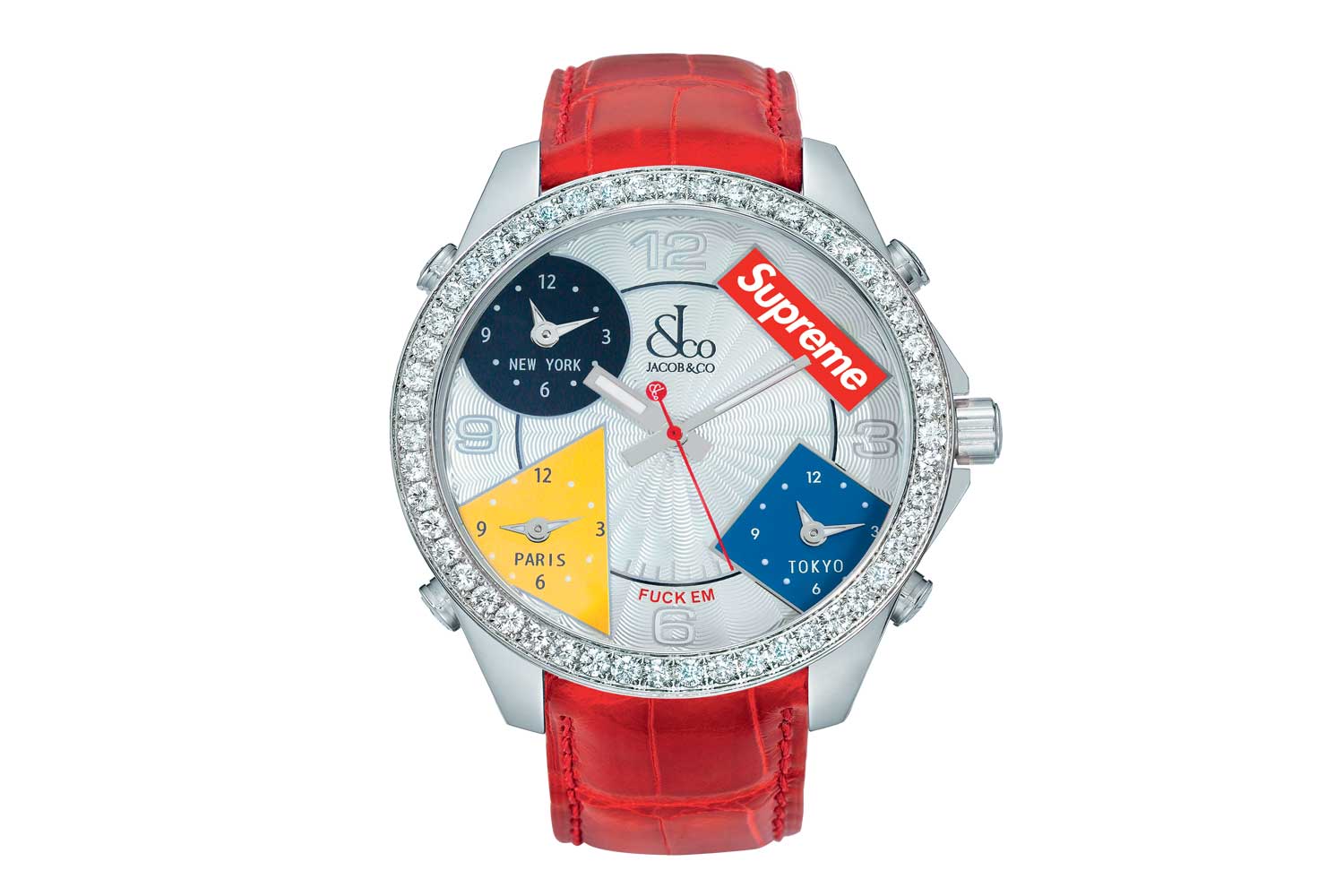
Jacob's 2021 collaboration with Supreme
The Transitional Period: The Quenttin
He explains, “When I get interested in a subject, I love to do research, I love to learn. And so I began to read about traditional complications and high watchmaking. But, to me, I also knew there was a client looking for something ultra complicated, three-dimensional, highly animated, beautifully made but also non-traditional in design.” Jacob started spending significant time in Switzerland, at which point he met Mathias Buttet, a pedigreed high complications specialist that had created a company, BNB Concept, building hyper complicated watches for brands without this in-house competence. In 2007, Jacob Arabo launched his first overture into high watchmaking with “Quenttin,” a wild timepiece incorporating seven mainspring barrels and a vertical tourbillon.
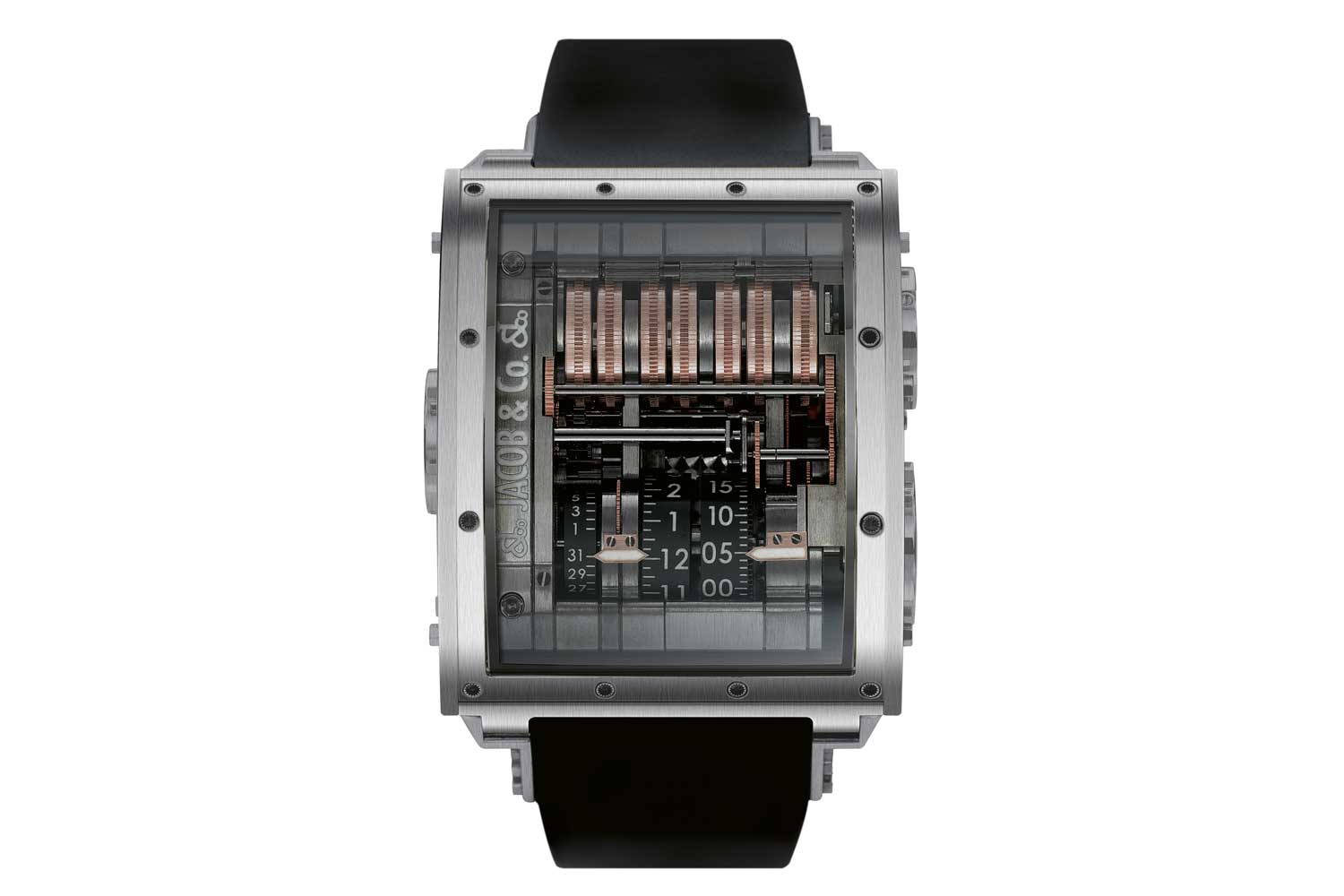
Jacob's first overture into high watchmaking, the Quenttin — featuring seven mainspring barrels and a vertical tourbillon
But then in 2009, resulting from the financial crisis, BNB went bankrupt. This came about from the abrupt end of purchases for the wild, hyper expensive, type of independent watchmaking BNB was fueling for brands like HD3, Concord and Franc Vila. Mathias Buttet became Hublot’s in-house high comp specialist, brought there by the legendary Jean-Claude Biver. Amusingly, that same seven- barrel vertical tourbillon concept is today the basis for Hublot’s MP-05. But what is clear about the Quenttin is that Jacob was interested in pushing the horological envelope to the furthest edge.
He explains, “It was an incredible moment to see the type of creativity that was possible with modern watchmaking, to go beyond the traditional complications of the perpetual calendar, tourbillon and minute repeater. The idea of the Quenttin was a watch that you wouldn’t have to wind for an entire month. That was to me something remarkable. Also, the architecture of the movement was something impressive because it reminded me of the engine of a supercar. At the same time, the lesson I learned from the Quenttin was that, in the future, I wanted to make these kinds of super complications but in a way that was personally meaningful to me. Even if I was to work with the best high complications specialists, the movements had to be exclusive to me.”
The Horological Journey Begins: Epic SF24
So, Jacob began to do his research and he scoured the Swiss horological landscape for a truly brilliant young voice. During this time, he was raising his family with three sons, David, Benjamin and Joey. Says Benjamin, “He was a great dad and someone who always wanted to spend time with us. He really pushed us to play sports. For me, that was basketball and, because of my dad, tennis as well. We always spend time together as a family, and I remember even as a boy around this time, my dad talking about watches. He was so excited because he had met someone that could help him realize what he had in his mind.” What Jacob had in mind, specifically, was the 2013 Epic SF24, which I have to say is an absolutely brilliant watch. To me, it is the clear articulation of Jacob’s intent to create a watch that, while visually dynamic, was also something deeply horological and incredibly functional.
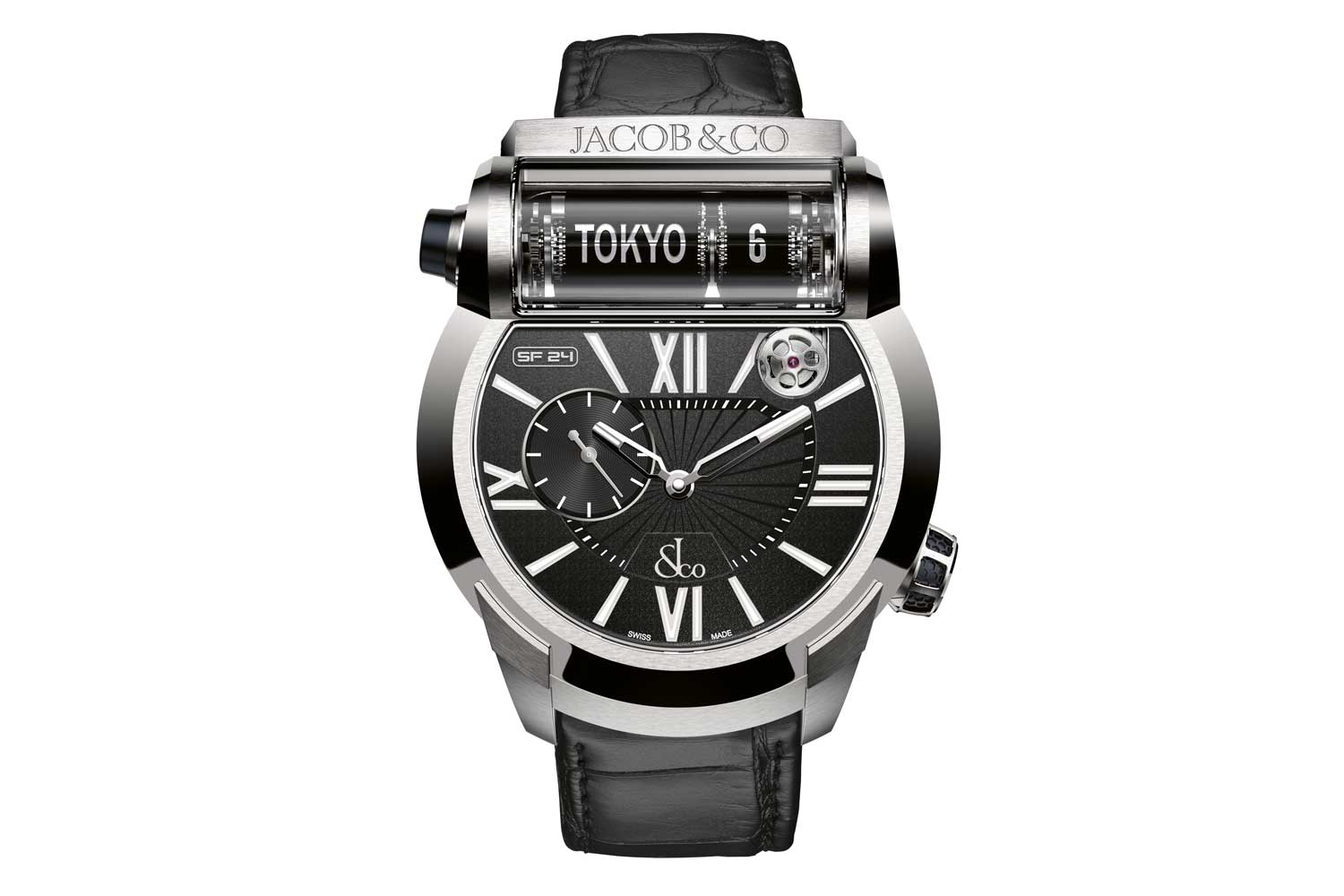
Jacob and Co.'s Epic SF 24 Limited Edition Titan
A New Icon is Born: Astronomia
Not content with this first creation, it would be Jacob’s next project that would yield what I believe is the most significant timepiece of the modern era. Says Jacob, “I knew that watches were evolving, and I wanted to create something that was totally unique. I wanted something related to space, something that was completely three- dimensional and something with a case that was totally open so that you could see the movement from every angle.”
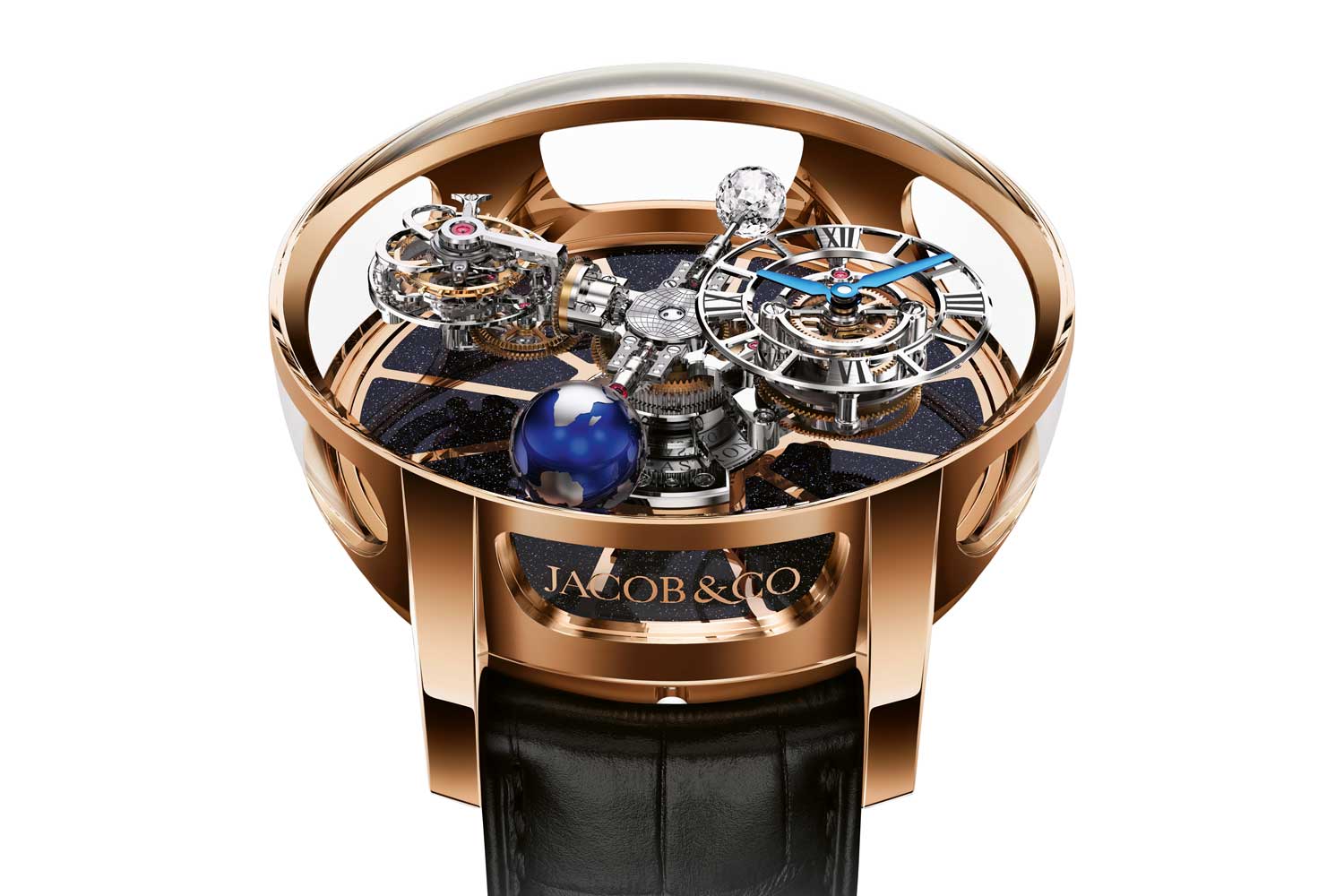
Jacob and Co. Astronomia Tourbillon
What Jacob did was to essentially unite these two types of watches to create an altogether new, unique and totally animated method of representing time. I would define the Astronomia not so much as a traditional timepiece but more a poetic work of kinetic sculpture that tells time. In many ways, it is an extension of Swiss artist Jean Tinguely’s famous “Metamatic” of kinetic art sculptures united with time-telling innovation. As I described in the opening paragraph of this story, to peer into the microcosm of the Astronomia for the first time is an awe-inspiring moment. It is based on a four-arm carriage that completes a full clockwise revolution each 20 minutes. It features a triple-axis gravitational tourbillon with 20-minute, five- minute and 60-second rotations of each axis, a floating dial that shows hours and minutes and is always oriented with 12 o’clock in the correct place despite its position on the dial, a 288-faceted Jacob-cut diamond and a magnesium globe that both rotate once on their own axis at 60 seconds.
You can see every side of the triple-axis tourbillon as it completes its full rotation on the dial. The idea is that this incredible movement is all driven by a single barrel. According to Jacob, one key challenge was that each arm of the carriage must be perfectly counterbalanced with its counterpart on the opposite side. For example, the mass of the Jacob-cut diamond had to be exactly the same as the mass of the earth; the mass of the hour and minute dial had to be identical to that of the triple-axis tourbillon.
Says Jacob, “When you put the Astronomia on your wrist, it is like nothing else in terms of the level of animation you enjoy. Every part of it is moving each part at its own distinct speed. It really is visual poetry.”
The Astronomia would become a vehicle allowing Jacob to further push the limits of what was possible. The next version of the watch would be called the Astronomia Sky, which is my favorite version of this incredible movement. Here you have the same four-arm carriage completing a revolution every 20 minutes, but placed in the center of the carriage is a stunning three-dimensional titanium representation of the earth that rotates on its own axis within a half dome of sapphire, which acts as a day/night indicator. You have, on each of the arms, a 288-facet yellow sapphire that rotates on its own axis, the signature triple- axis tourbillon, the floating hour and minute indicator, and an amazing three-dimensional seconds indicator that brings to mind a spacecraft orbiting earth. Under all this, you have a star chart that completes a full rotation once a year. Through a fixed ellipse shaped oculus, you have a representation of sidereal time (star time) from the Northern Hemisphere. Finally, the edge of the rotating star chart is fixed with the months. Jacob has even gone so far as to develop his own app to allow setting the Astronomia Sky accurately via a straightforward and fun process.
He elaborates, “Each arm has a unique complication, something exclusive to Jacob & Co.: A magnesium and hand-lacquered globe of the earth, a spherical-shaped diamond with 288 facets that I named the ‘Jacob-Cut,’ a triple-axis tourbillon and a subdial for the hours and minutes. Each satellite is unique, and two have patents. Each requires exceptional craftsmanship. Also, all of the complications have to be identical in their weight or else the movement won’t function. This is another example of superb craftsmanship. This stage that I created is very versatile. It changes from astrological stories, art works, landscapes and anything else I can imagine.”
The Astronomia has also been extrapolated into a version known as the Astronomia Solar, a watch that replaces the triple axis tourbillon with a double axis version, allowing the movement to sit inside a smaller sized case at 44.5mm. The now 10-minute carriage is reconfigured to have six arms. That’s right, six arms, three of which are animated. These include an arm bearing a stunning miniature representation of the earth rendered in magnesium, one featuring the differential-driven self- leveling time indicator, one bearing the incredible double- axis tourbillon. In the center of the carriage is a 1.5 carat, 288-facet Jacob-cut citrine stone that represents the sun. The three additional arms each carry another 288-facet Jacob-cut gemstone. These are specifically an amethyst, a topaz and a peridot stone. By virtue of the carriage’s rotational speed of one full revolution every 10 minutes, at the same time, the solar version of the movement adds to it a Skylayer, a stunning depiction of space with additional planets in the form of half dome gemstones. The Skylayer features seven planets made of cabochon-cut precious stone half-spheres: white granite for Mercury, rhodonite for Venus, red jasper for Mars, pietersite for Jupiter, Tiger’s Eye for Saturn (18K rose gold applique for the rings), blue calcite for Uranus, and lapis lazuli for Neptune.
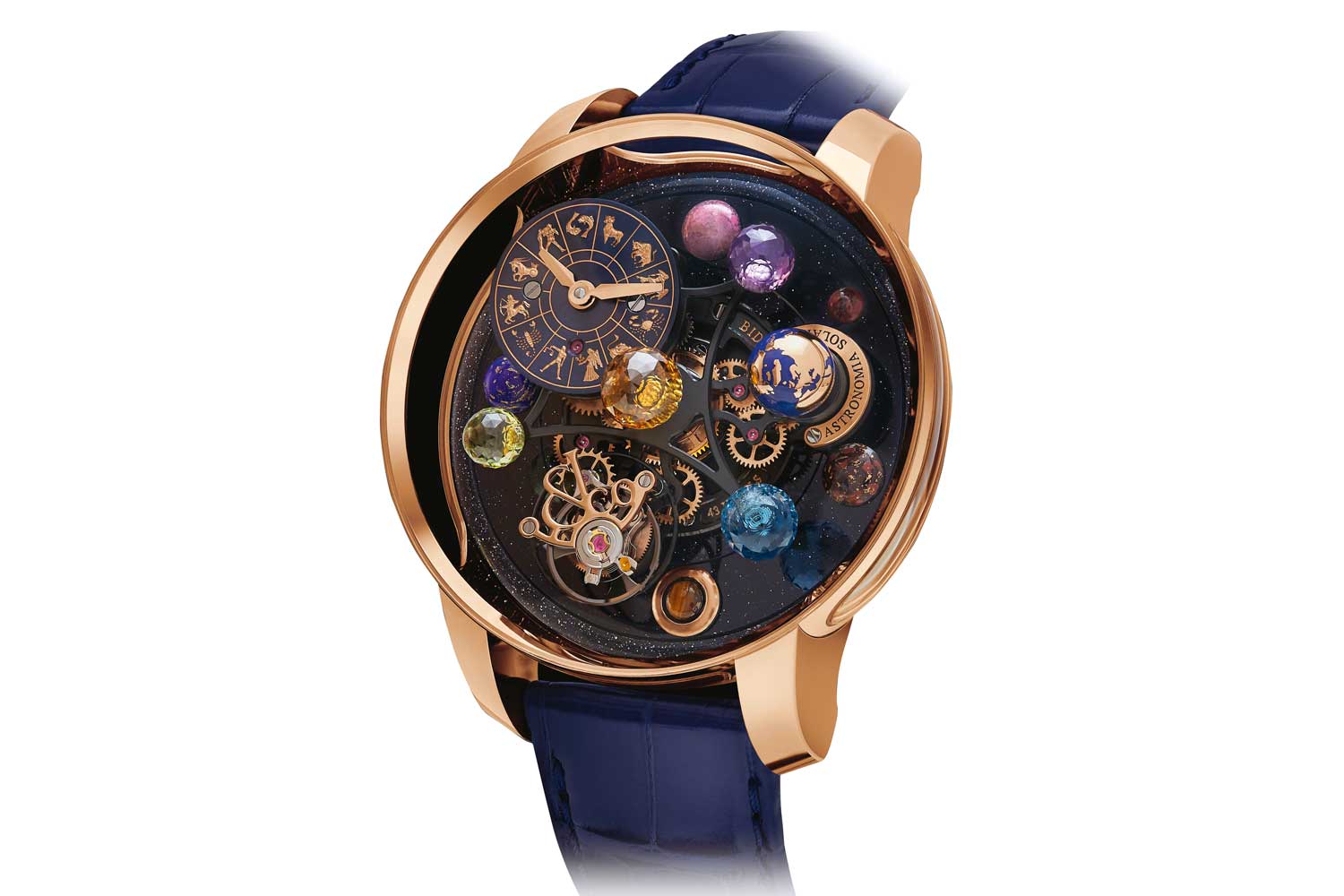
Astronomia Solar Zodiac
His inventiveness also brought Jacob to create two additional utterly crazy expressions of the Astronomia’s rotating display. The first is the Astronomia Casino that adds as its base layer a functional roulette wheel. Yes, this is the watch you’ve seen Connor McGregor and Drake wearing. But perhaps the wildest version of the Astronomia was launched in 2020 and is aptly named the Astronomia Typhoon. This version is similar to the original Astronomia. It features the same triple-axis tourbillon, the same self-leveling differential driven floating hour and minute indicator, all mounted on a carriage that makes a full revolution once every 20 minutes. But hit the Typhoon switch integrated into the side of the watch case, and the entire carriage will complete four complete revolutions in a blazingly fast 16 seconds. That it achieves repeats of four-by-four seconds revolutions without losing a second of accuracy to the underlying timekeeping makes it perhaps the most impressive feat.
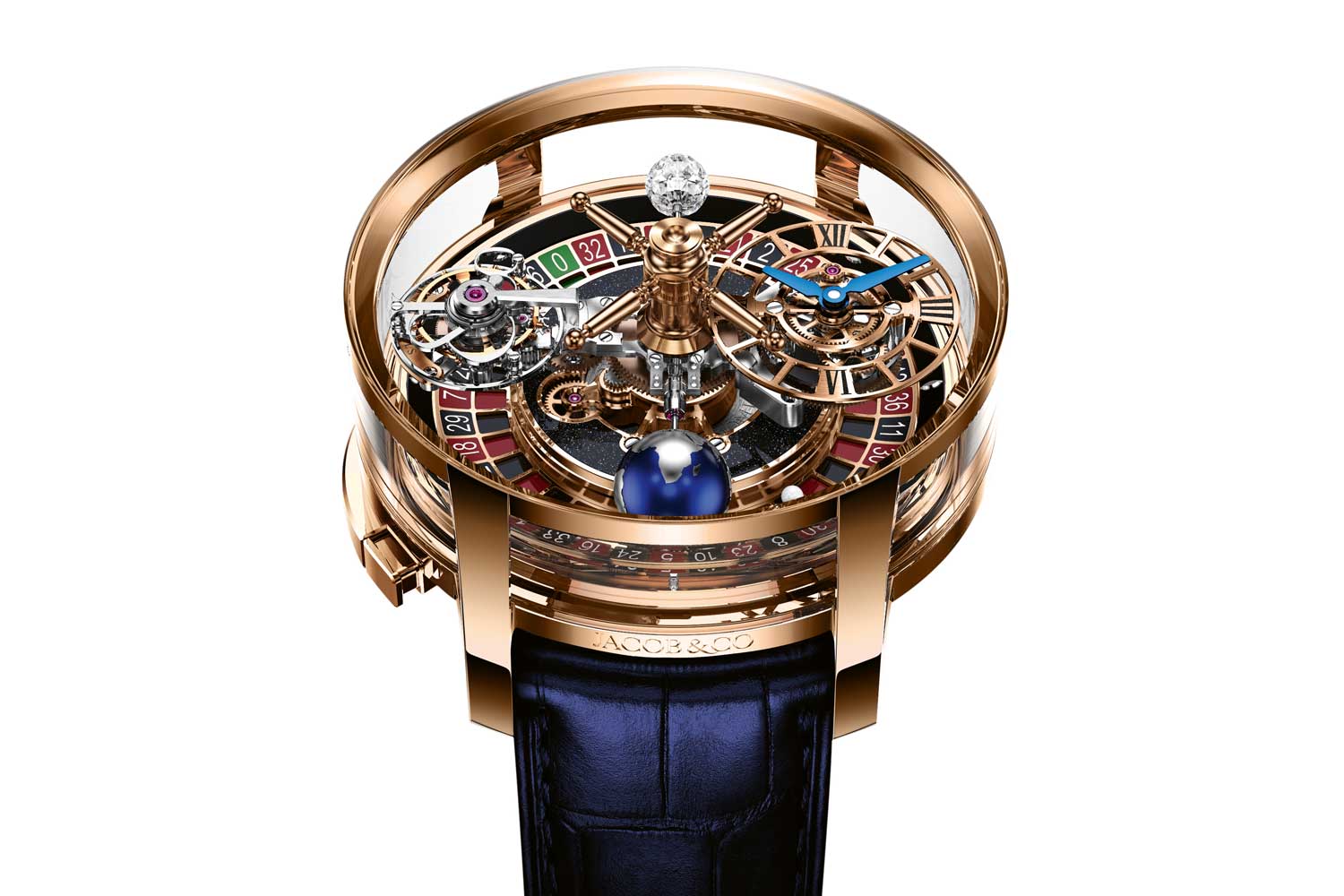
Astronomia Casino
The Ultimate Performance Machine: Twin Turbo Furious
When it comes to authenticity in watchmaking, no complication is easier to judge than a minute repeater. The gulf between the few watches with truly spectacular songs and those that merely strike out to the time with competence but a lack of musicality is immense. Says the internationally renowned, Singapore-based watch collector who goes by the Instagram handle Santa Laura, “When I first started looking at the Twin Turbo Furious, I thought to myself, this is incredible. Who else can combine two triple-axis tourbillons, a column wheel chronograph and a decimal minute repeater at a price that, in relative terms, is actually a strong value? I really like the aesthetics of the watch. But what sold me on it finally was the quality of the minute repeater. I had some friends that didn’t believe me, so we each brought a minute repeater one night, and we activated it without revealing what it was. Out of the watches that we brought, everyone universally thought the Patek with cathedral gongs was the best, and the second best was my Jacob Twin Turbo Furious, which has all these added complications on top of it.” Why a decimal minute repeater? Says Benjamin, “Since Kari Voutilainen created the first decimal minute repeater back in 2005, my father has always felt that was a more intuitive way to represent the minutes. When we had the opportunity to create our own minute repeater, he wanted to incorporate this function.”
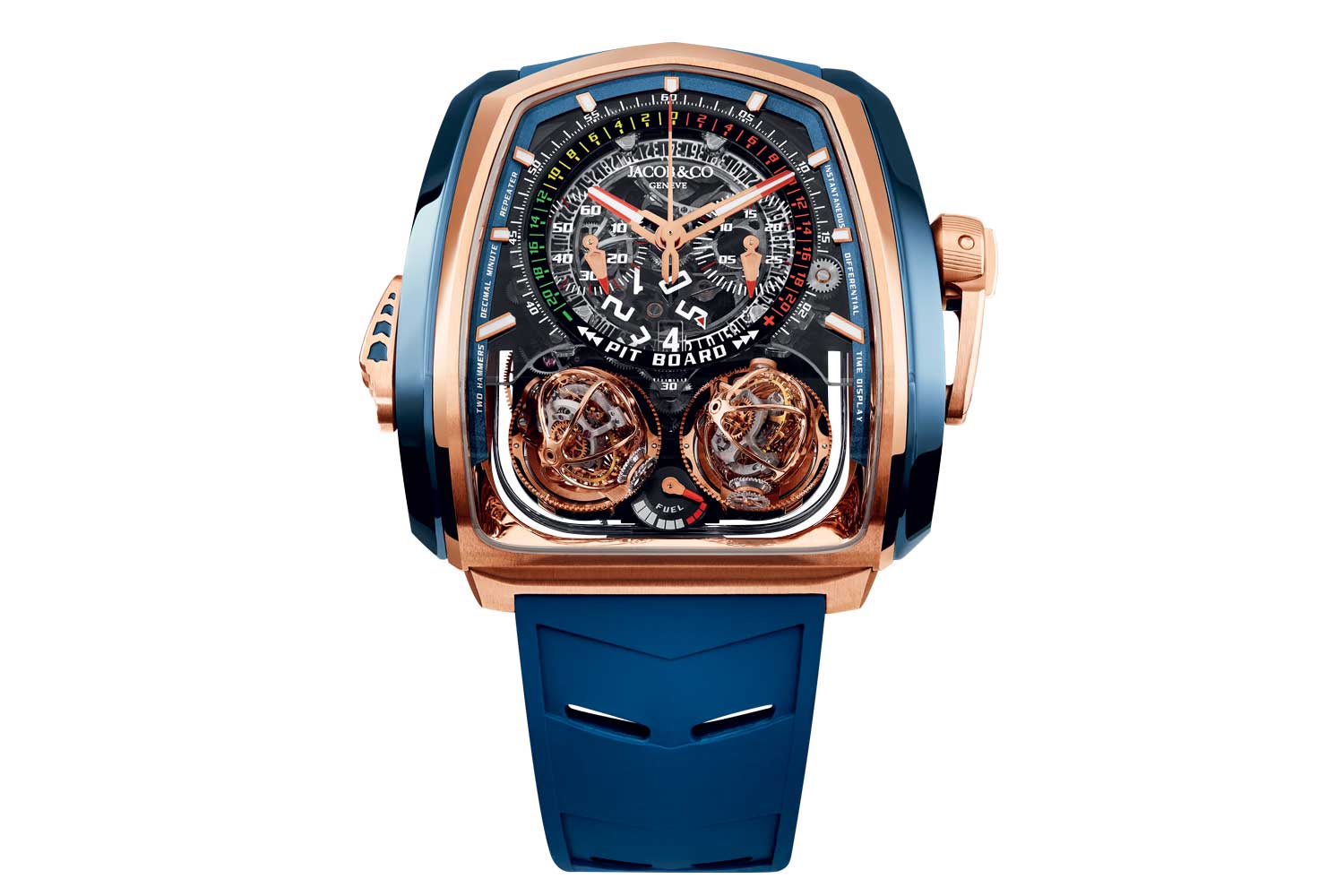
Jacob and Co.'s ultimate performance machine, the Twin Turbo Furious
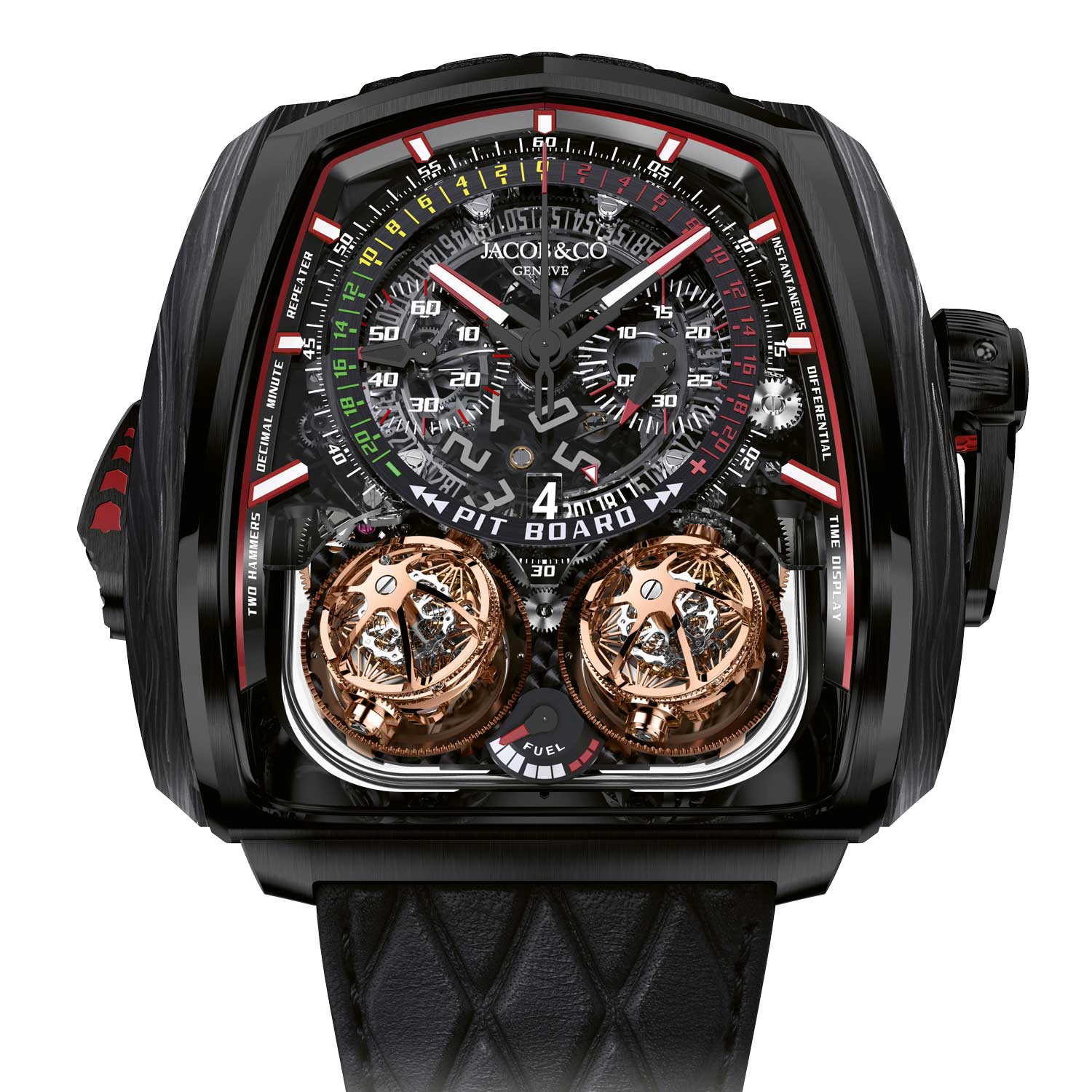
Jacob and Co. Twin Turbo Furious
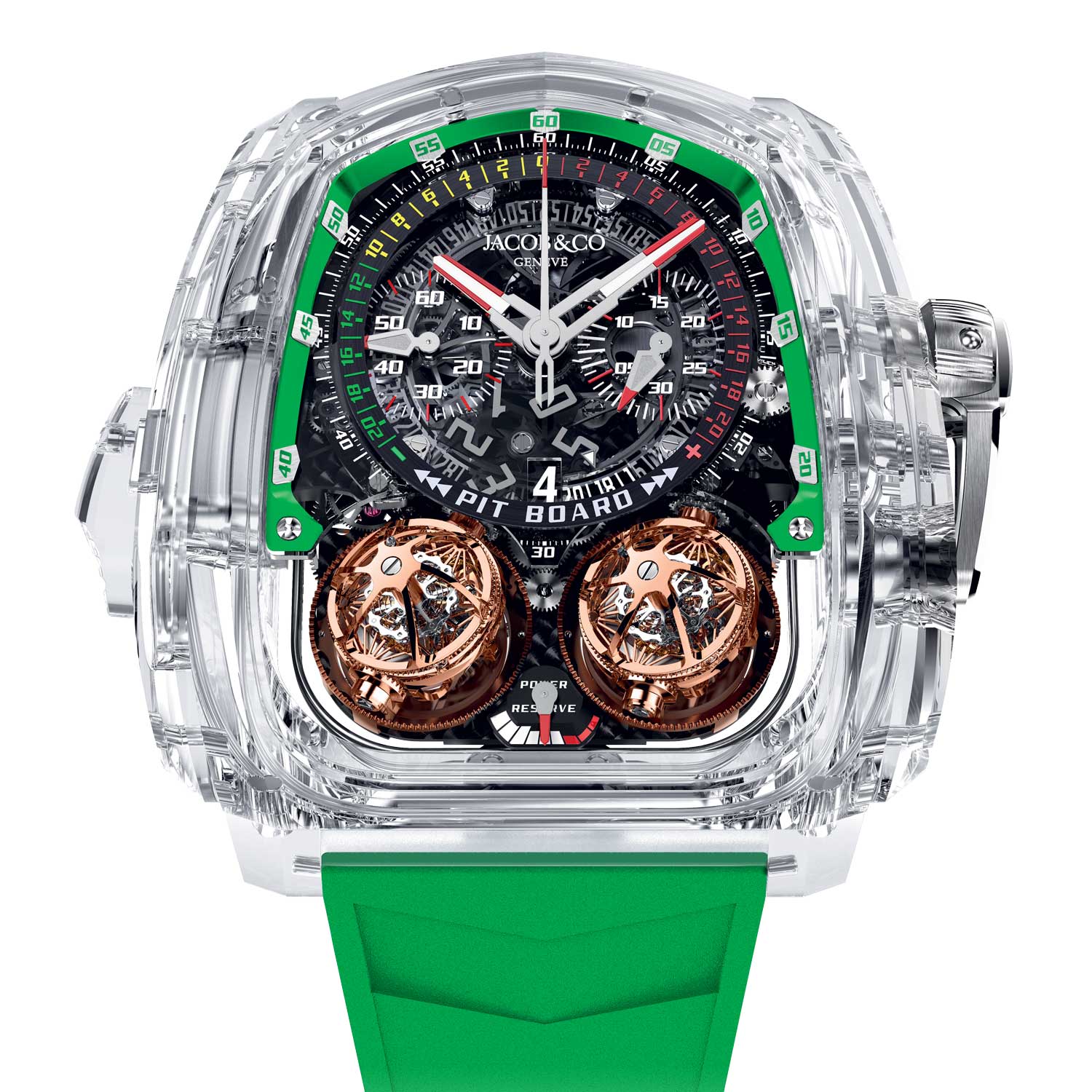
The Twin Turbo Furious Sapphire
Says Santa Laura, “Honestly, it’s actually quite comfortable for all the firepower it packs, and I have to say its presence on the wrist is like nothing else. I’ve owned this watch now for several years, and it never ceases to delight.”
Says Jacob, “The Twin Turbo is at the same level as the Astronomia in complexity but unveils a different more technical, more motorsports and performance driven dimension of the brand. It is really an incredible combination of complications, and I would like to point out that, in each of these, whether[it is the minute repeater, the tourbillon or the chronograph, we have elevated performance to an all-new dimension.” He laughs, “I would call it the equivalent of a supercar on the wrist, except for the fact that I have a watch that literally is a supercar for the wrist.”
Supercar For the Wrist: Bugatti Chiron
With the maturation of his horological voice and the crystallization of his watchmaking vision, one of the key focuses for Jacob Arabo would be on translating the concept of automatons into the language of the modern world and giving them a new relevance. The term “automaton” comes from the Greek automata and means “acting of itself.” They are miniature figurines engaged in some repetitive action and were combined with tower clocks in the mid-14th century in Europe. In 1770, a Swiss watchmaker named Pierre Jaquet-Droz rose to prominence by creating a series of automatons capable of remarkably human-like actions, such as signing its own signature. Since the ’90s, automatons began to appear on wristwatches to create some dial side animation to accompany traditional complications like minute repeaters.
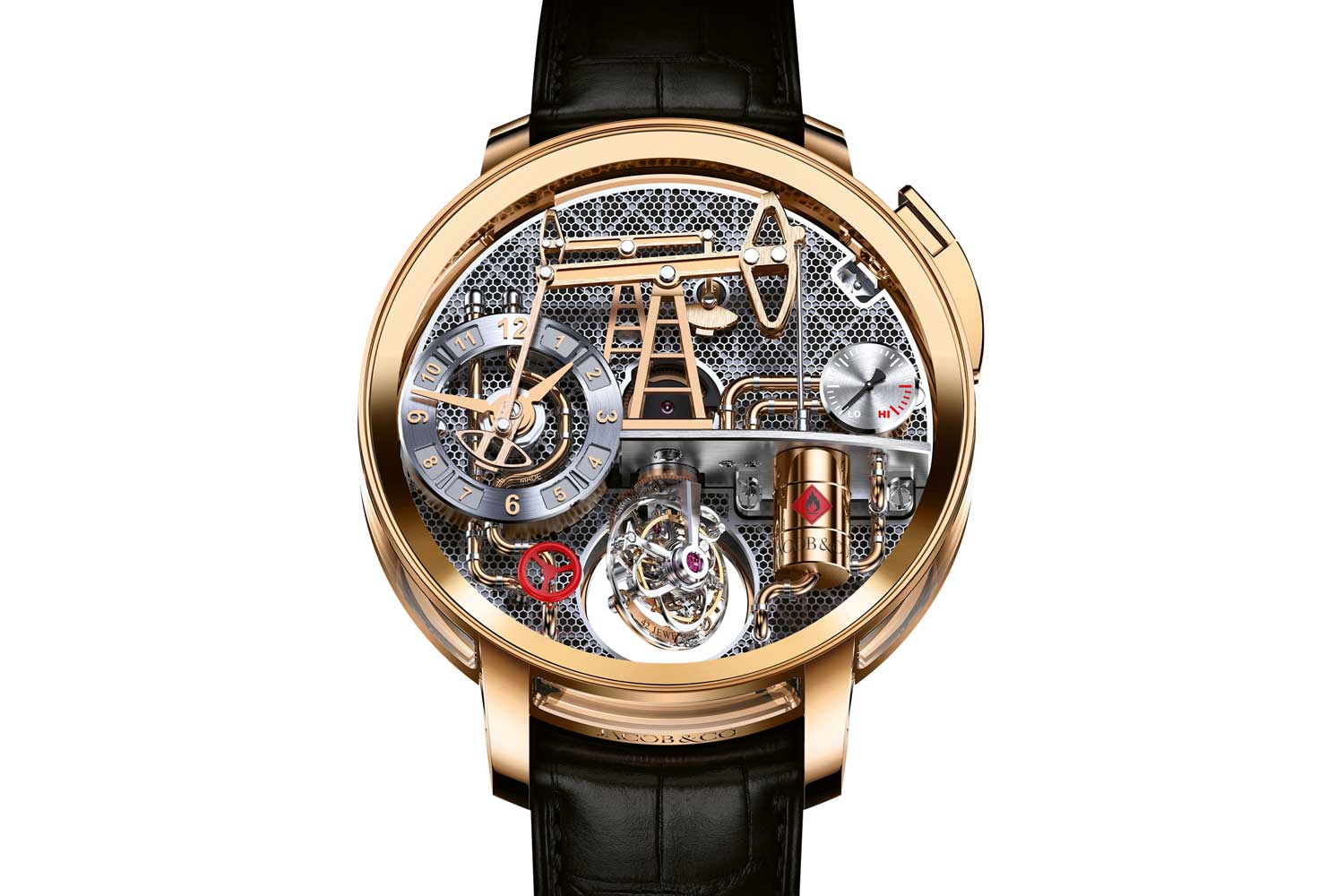
Another distinctive creation is the Oil Pump Rose Gold featuring Jacob and Co.'s double-axis tourbillon and inspired by the tradition of automatons in the watch industry
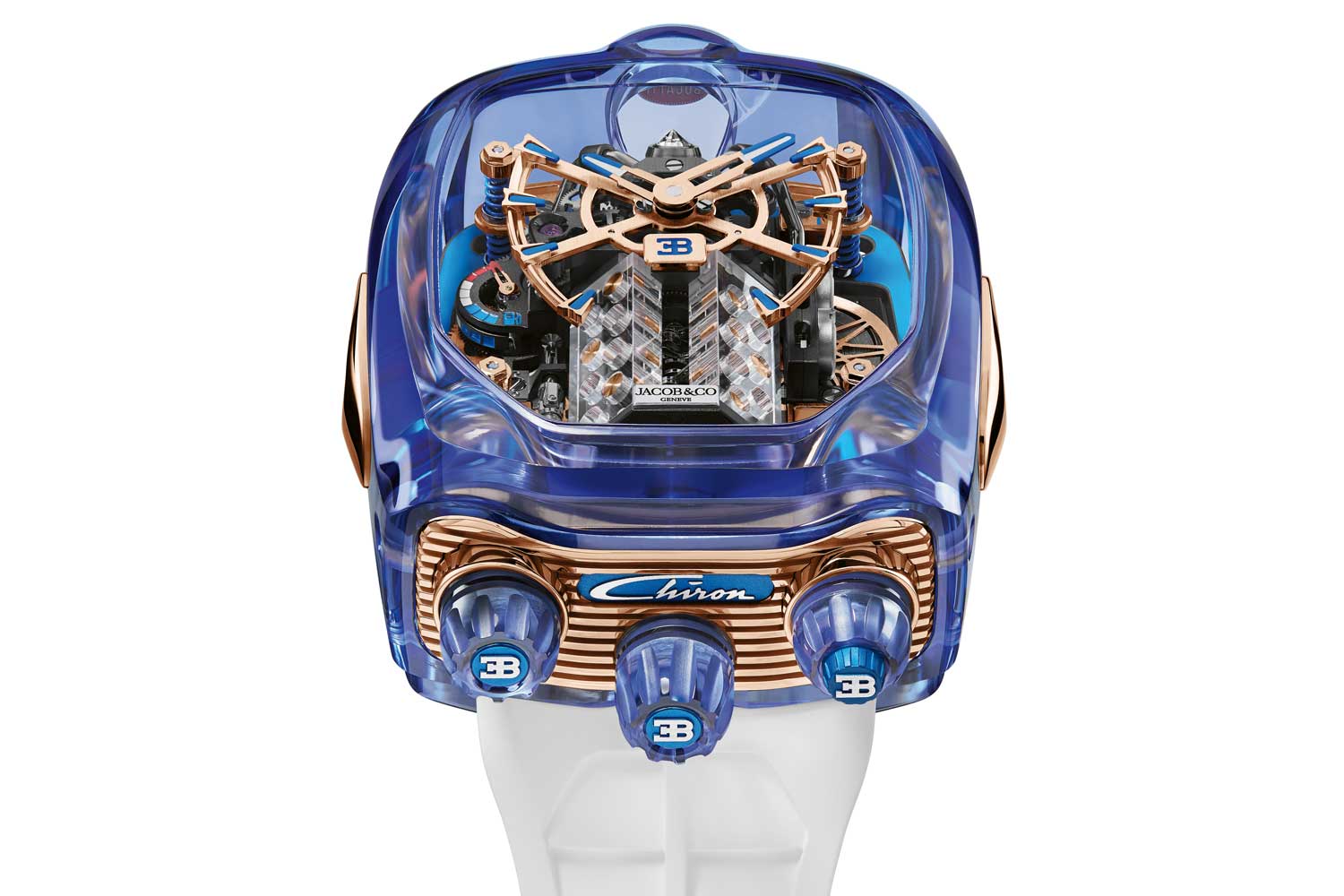
The stunning Bugatti Chiron Blue Sapphire Crystal
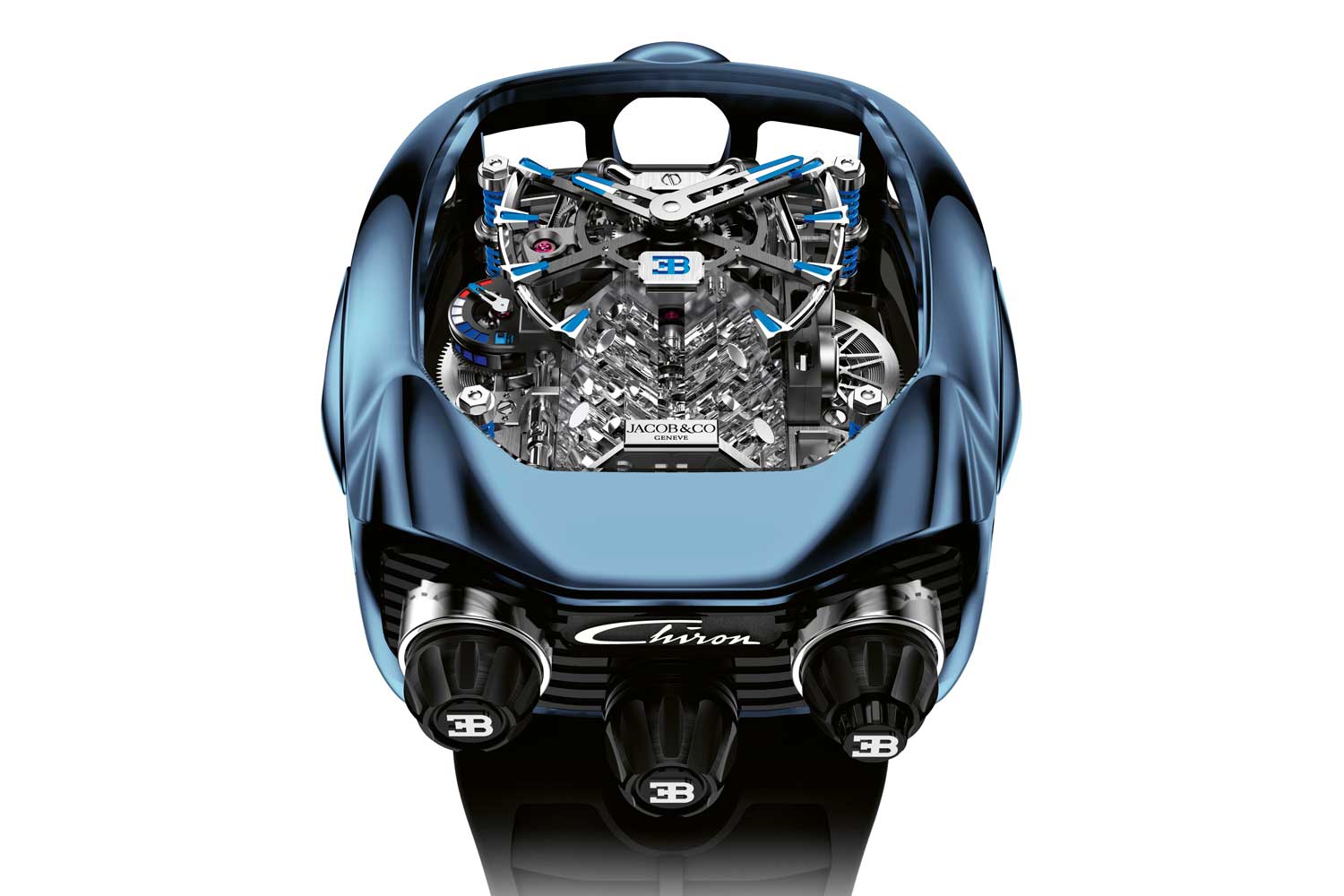
An iteration of the Bugatti Chiron in blue titanium
What’s That Sound: Musical Watches
Musical watches go back to music boxes where a cylinder with pre-programmed pins would turn and strike out a tune on a musical comb. There were already several watches that had integrated this complication, such as Breguet’s La Musicale that plays a piece of music from Bach. Indeed, Swatch Group’s Marc Hayek even has a pièce unique musical watch that plays the opening refrain from AC/DC’s “Thunderstruck.” But where Jacob struck horological gold was to combine the idea of a musical watch with one of the most famous pieces of music in American contemporary culture. The theme song to The Godfather, the 1972 masterpiece directed by Francis Ford Coppola, is both totally unforgettable and utterly intrinsic to the narrative of the film.
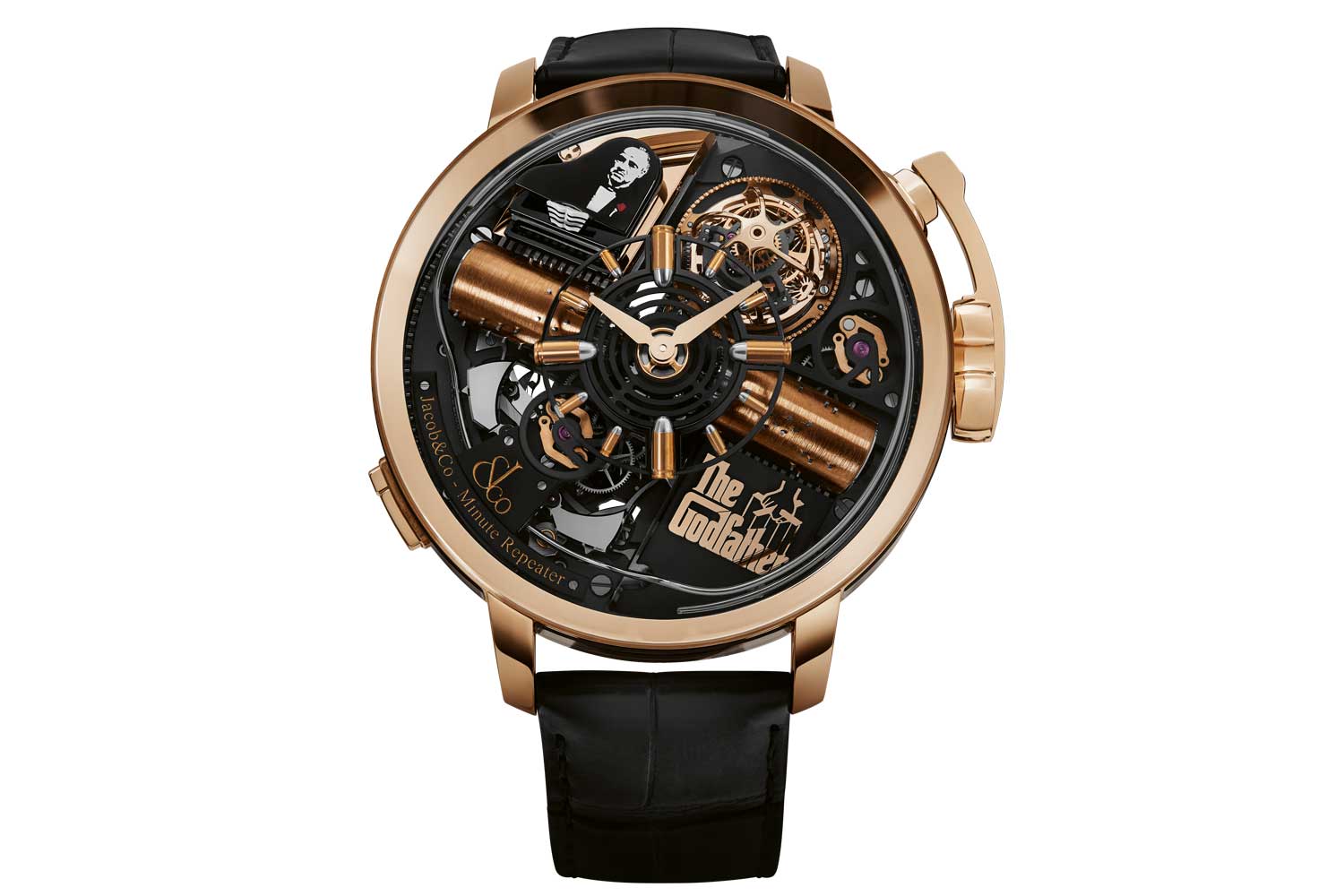
Jacob and Co. Opera Godfather Minute Repeater Bullet
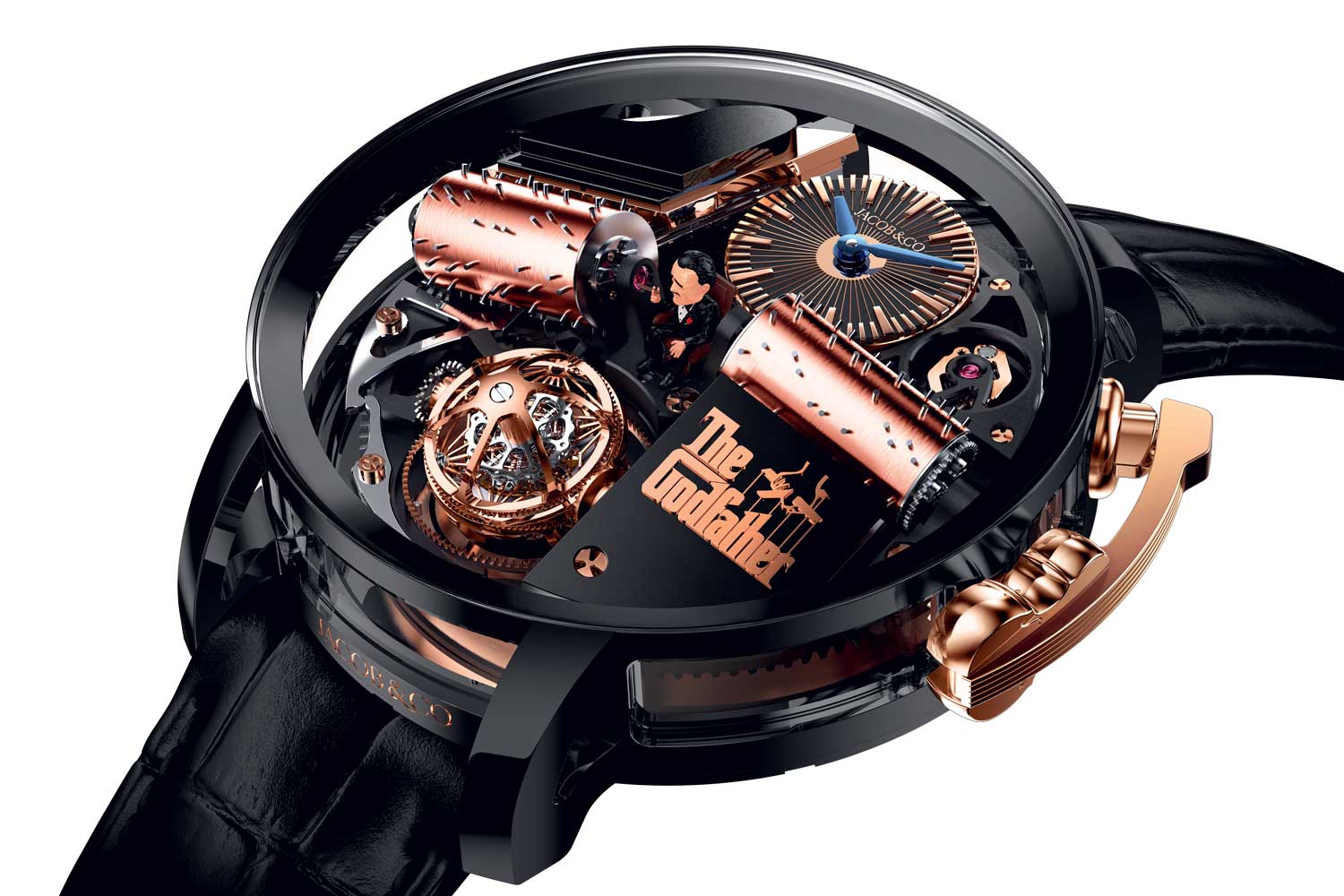
Opera Godfather Musical Watch in rose gold
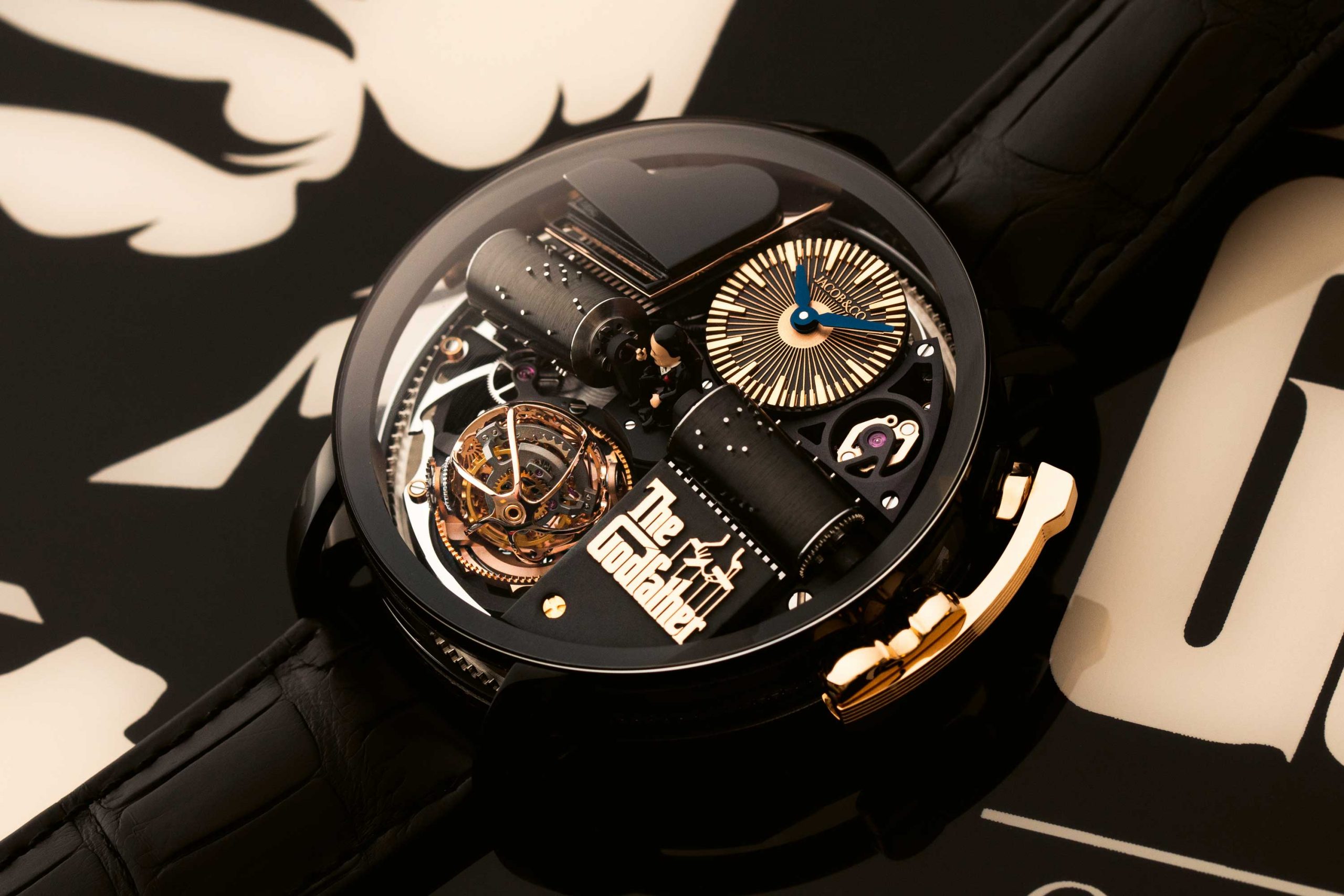
The Opera Godfather Musical Watch in black DLC and grade 5 titanium
Who Is Jacob Arabo?
After my whirlwind experience of several days in New York with Jacob, what can I conclude? The first is that one should never ever get into a tequila drinking competition with him. The second is that Jacob’s vision for true high watchmaking is just under a decade old, but if you look at what he’s achieved in the nine years since the launch of the Epic SF24, his rise into legitimately claiming a place amongst the world’s best watchmakers is valid. He’s at a good place in his life. He is successful beyond his wildest dreams as a young man. He has a great family. All his sons — David, Benjamin and Joey — are successful entrepreneurs, and Benjamin has taken over the reins to become the CEO of Jacob & Co. Jacob and Benjamin have a very charming relationship, one of genuine trust, affection and mutual respect between father and son. In his own way, he is an optimist and an idealist, and I like both these qualities in him immensely. Maybe that’s another reason why I like his watches as much as I do. Because they appeal to anyone that believes that with hard work, strength of character, immense fortitude and an indefatigable work ethic, dreams come true.










